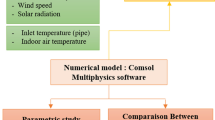Abstract
The passive cooling system of a large, multi-storied, commercial complex is considered, where the building mass is used for storing night time coolness. Fan driven air is forced through an air gap separating the concrete floors and ceiling slabs in order to achieve storage. A mathematical model is proposed for the air and slabs. Three numerical methods are considered: two using the traditional electrical analogy to heatflow, and finite elements for the other. The methods are compared through test examples and a choice is made. The resulting computer code allows for time varying air velocity in the ceiling/floor gap and, as a consequence, time varying convection. Measured input air temperatures at the entrance to the slab are used to drive the model. Investigations by sensitivity studies for forced air velocity, drift air velocity and convection, are described. Modelled slab outlet temperatures, using suitable parameter values, are compared with measurements and reproduce the trends and, to a reasonable extent, the details.
Similar content being viewed by others
Abbreviations
- B :
-
Thickness of the slabs
- d :
-
Width of the air gap
- D, D*:
-
Domain of the floor (or ceiling)
- ∂D :
-
Boundary of D
- f(t):
-
Temperature at the inlet to the air gap
- G :
-
Air gap domain
- L :
-
Length of the slabs, air gap
- T(x, t), T*(x, t):
-
Floor, ceiling temperature at position x and time t
- T ∞(x, t):
-
Air temperature at position x and time t
- c m :
-
Specific heat capacity of the storage material (concrete) J/kg°C
- k m :
-
Thermal conductivity of concrete W/m°C
- v :
-
Average air velocity m/s
- c a :
-
Specific heat capacity of air J/kg°C
- ρ a :
-
Density of air kg/m3
- α :
-
A constant in Eq. (4)
- h c :
-
Convective heat transfer coefficient W/m2°C
- h r :
-
Radiative heat transfer coefficient W/m2°C
- m a :
-
Air mass flow rate kg/s
- ρ s :
-
Density of concrete kg/m3
References
Holmes M.J., Wilson A.: Assessment of the performance of ventilated floor thermal storage systems. Ashrae Trans. 102(1), 698–707 (1996)
Ren M.J., Wright J.A.: A ventilated slab thermal storage system model. Build. Environ. 33(1), 43–52 (1998)
Henwood D.J., Bonnet J.: A gentle introduction to finite elements. MacMillan, New York (1996)
Schmidt, F.W., Willmont, A.J.: Thermal storage and regeneration, p. 33. McGraw-Hill, New York (1981)
Marewo, G.T.: D Phil thesis.Mathematical modelling of passive cooling in buildings, University of Zimbabwe, awarded December 2005
Morton, K.W., Mayers, D.F.: Numerical solution of partial differential equations, p. 29. Cambridge University Press, Cambridge (1994)
Marewo G.T., Henwood D.J.: A Mathematical model for supplying air cooling using a packed bed. Build. Serv. Eng. Res. Technol. 27(1), 11–26 (2006)
Chartered Institute of Building Services Engineers: CIBSE Guide C: Reference data. Butterworth-Heinemann, Oxford (2001)
Author information
Authors and Affiliations
Corresponding author
Rights and permissions
About this article
Cite this article
Marewo, G.T., Henwood, D.J. A mathematical model for the thermal behaviour of a ventilated floor slab. Afr. Mat. 24, 259–277 (2013). https://doi.org/10.1007/s13370-011-0056-4
Published:
Issue Date:
DOI: https://doi.org/10.1007/s13370-011-0056-4




